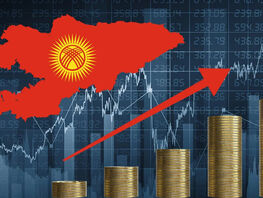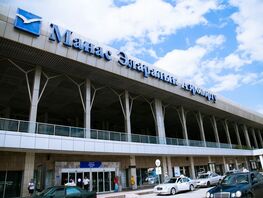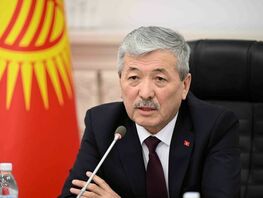External management was introduced at the country’s main gold mine Kumtor on May 17, 2021. Instead of three months, it dragged on for more than a year. The public was promised that everything would be fair, open and transparent.
In fact, there are even more questions about the work of the budget-forming enterprise.
Reports, which are now very rarely published by the enterprise, do not help. They don’t answer the main questions. It is simply impossible to analyze what is actually happening at the mine using these figures. Work at the mine after the de facto nationalization is carried out in a semi-secret mode.
How Kumtor pays taxes
The payment of taxes by Kumtor is one of the few, if not the only, part of the work that can actually be traced both from the reports of the company itself and from the statistics of the Ministry of Finance. We must pay tribute — with the introduction of external management, the amount of transfers to the budget really increased. In addition, Kumtor began to pay a fee for the development of the mineral resource base — 4 percent of the proceeds in excess of planned taxes.
At least $23.6 million of this type of payment was transferred to the country’s budget in 2021.
As for other deductions, according to the enterprise itself, taxes and payments amounting to 13.6 billion soms were paid last year comparted to a plan of 9 billion soms. The plan was overfulfilled by 4.6 billion soms, or 51 percent.
However, it is worth noting that in December 2021, the Ministry of Finance reported a drop in revenues from Kumtor by almost 3 billion soms. It was not about all transfers, but only about the tax on gross income. But the company has not given exact information about types of taxes and payments that are transferred to the budget each month of the year. Therefore, it is impossible to understand where is a real growth and where are achievements due to external management.
Nothing has changed in 2022. The company provides figures on the payment of taxes and payments. According to the results of the first half of 2022, about 20.5 billion soms were transferred to the budget of Kyrgyzstan, while the plan was 7.4 billion soms. The figures have grown, but it is not known at the expense of what kind of taxes.
Kumtor Gold Company is proud to announce that it has become one of the first mining companies in Kyrgyzstan to start paying for water. From November 2021 to June 2022, at least 257.4 million soms were paid for the use of surface water resources. This is good, but the largest gold mining company simply had no other choice. In addition, being under external management, the company simply had to show execution of all the laws of the country.
How gold was mined
It is even more complicated with indicators for the extraction and sale of gold. According to official data, 4.79 million tons of ore were mined in 2021, which contains 14.7 tons of gold.
This is 6.8 times more in terms of the volume of ore and 3.1 times more in terms of the content of gold in ore than it was mined in 2020. But this is a pandemic year. There were coronavirus restrictions, and ore that was poor in gold content was mined. Comparison with such data is always in favor of new indicators. The current management of Kumtor does not compare its work with more productive years in terms of ore mining.
Meanwhile, previous reports showed that in 2019, 18.68 tons of gold were mined, in 2020 — 17.29 tons.
Compared to these figures, gold production decreased by 3.98 and 2.59 tons, respectively. There is one more point. The figures for gold mining are also presented for the whole year. But external management at the mine was introduced only on May 17, 2021. It is unknown how much gold was mined under Centerra Gold, and how much after the introduction of external management.
At least 2.9 million tons of ore were mined in the first half of 2022. About 229,006 troy ounces, or 7,123 kilograms of gold, were produced from it.
If the volumes of mining and processing of ore are the same, then by the end of the year 14.2 tons of gold will be mined. But the company itself has planned a different figure — more than 17.3 tons. It is a big question whether it be possible to fulfill the plans.
Whom and why the gold was sold
But the biggest and most painful question for today is where did Kumtor’s gold go. Kumtor Gold Company CJSC previously reported that the total proceeds from the sale of gold last year amounted to $856 million.
At the same time, the Cabinet of Ministers clarified that gold for $621 million was sold precisely during the period of external management.
At least 7,136 kilograms of gold were sold for six months of 2022. The total sales proceeds amounted to $426.2 million. Compared to the plan, the figure increased by $62.4 million. This is due to both the growth in sales volumes and the increase in the price of gold.
Everything seems to be fine. But civil society, activists and deputies have questions: to whom, how and at what price was the gold sold?
It is important to take into account several points here. Since May last year, Kyrgyzaltyn OJSC has not exported gold. Only the National Bank has the right to sell it. But the bank did not buy gold in such volumes last year. Gold sales are also lower than those mined and sold from Kumtor.
In addition, during the period of the proceedings around the gold mine, refinery of Kyrgyzaltyn OJSC was withdrawn from the Good Delivery List. This means that we could not sell our gold at the price of the world exchange.
Data on the export of the precious metal are very different. There seem to be figures for sales, but it is impossible to trace the real fate of Kumtor’s gold. The president and the head of the Cabinet of Ministers say that everything is under control and not a single gram of Kyrgyz gold will go anywhere without a trace. But the evidence of this looks flimsy, so even more questions arise.






